As has been visualized in other economic sectors, tourism industry also plays crucial role in the employment generation and socio-economic development in the state and the country as a whole. Besides the direct income generation from tourists, this industry generates jobs for thousands of people who are directly concerned with tourism and for many local people too, which of course, uplift the socio-economic standards of people in the tourist destinations. Such economic diversification in the modern era and rapid development of tourism industry owing to technological innovations such as transportation facilities and internet facilities are gearing to achieve significant progress in the social life of the people. Even if hill station tourism cannot generate employment for primary sector (agriculture, industry, fishing and mining, manufacturing, electricity, gas supply), it generates employment for thousands of people who are concerned with transportation, travel agency, hotels, restaurants, wayside amenities, building constructions, communications, purified water suppliers, traders selling eatable items along the waysides, tea and coffee sellers and owners of house stays and others. Having realized the significance of tourism, the government has focused its attention to explore the existing tourism potential and place sightseeing sector on the agenda of national development.
In Kodaikanal, tourism has generated jobs for a total of 4,460 local people, including 3,361 males and 1,099 females in and around this destination (Table -1) while the tourism in Sirumalai provides jobs for 1981 people, of which about 1464 are males and 517 are females (Table-2). Similarly, tourism in Ooty provides employment for 5337 people, including 3741 males and 1596 females (Table-3) while tourism in Coonoor creates jobs for over 2261 people, of which about 1562 are males and 699 are females (Table-4). Obviously, tourism in Valparai generates jobs for 3289 people, of which about 2358 are males and 931 are females (Table-5). Apparently, tourism in Meghamalai generates employment for 1943 people, of which about 1423 are males and 520 are females (Table-6). Noticeably, tourism in Yercaud generates jobs for 2854 people, of which about 2003 are males and 851 are females (Table-7). Practically, tourism in Yelagiri generates jobs for 2715 people, including 1806 males and 909 females (Table-8). Perceptibly, tourism in Kolli hills generates employment for 2473 people, of which about 1512 are males and 961 are females (Table-9).
The present study concludes that about 19230 men and 17558 women have opportunities for getting jobs due to the growth of tourism industry in the selected hill stations of Tamilnadu in the year 2018. Thus a total of 36778 local people get employment opportunities through tourism industry in these nine hill stations of Tamilnadu.
Table-1: Employment generation in Kodaikanal destination due to tourism industry.
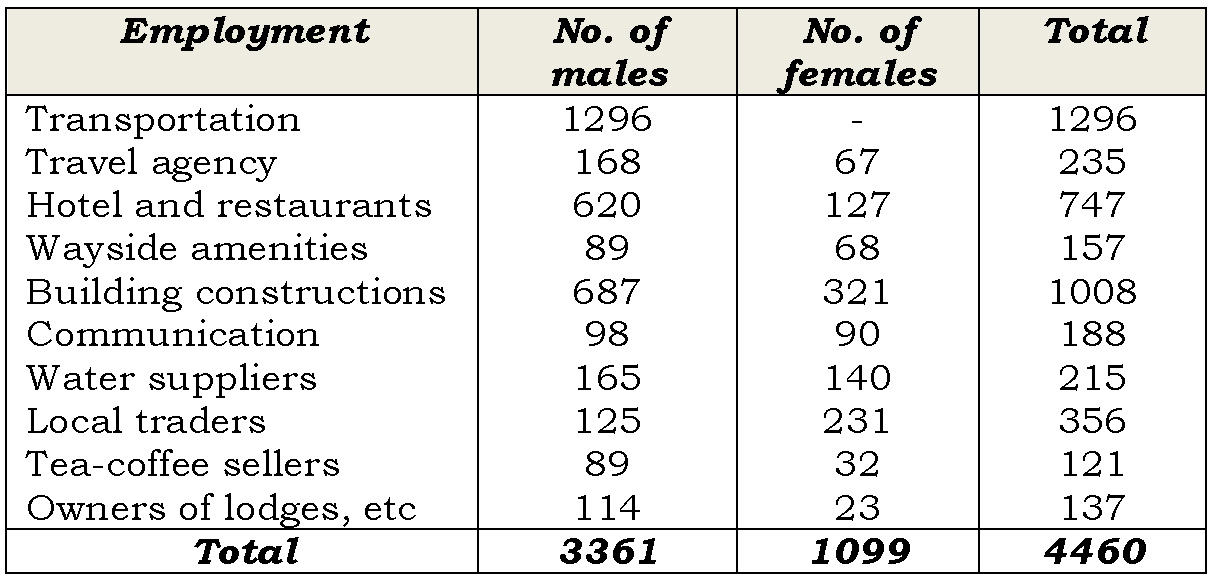
Table-2: Employment generation in Sirumalai destination due to tourism industry.
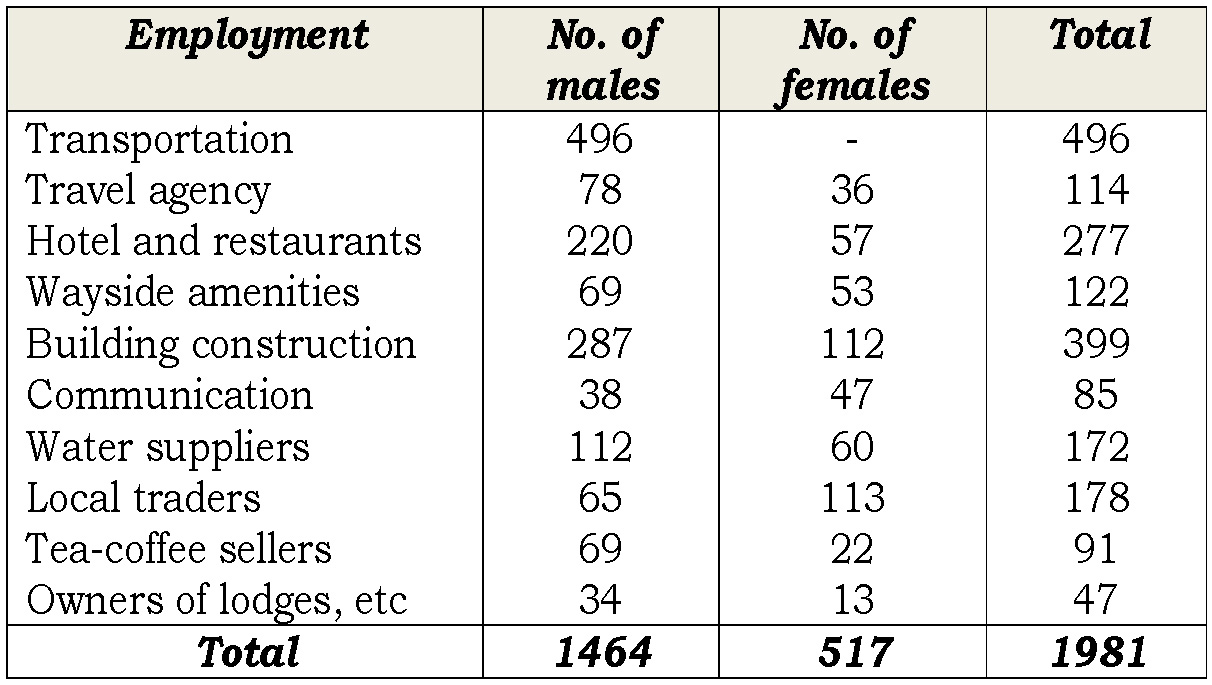
Table-3: Employment generation in Ooty destination due to tourism industry.
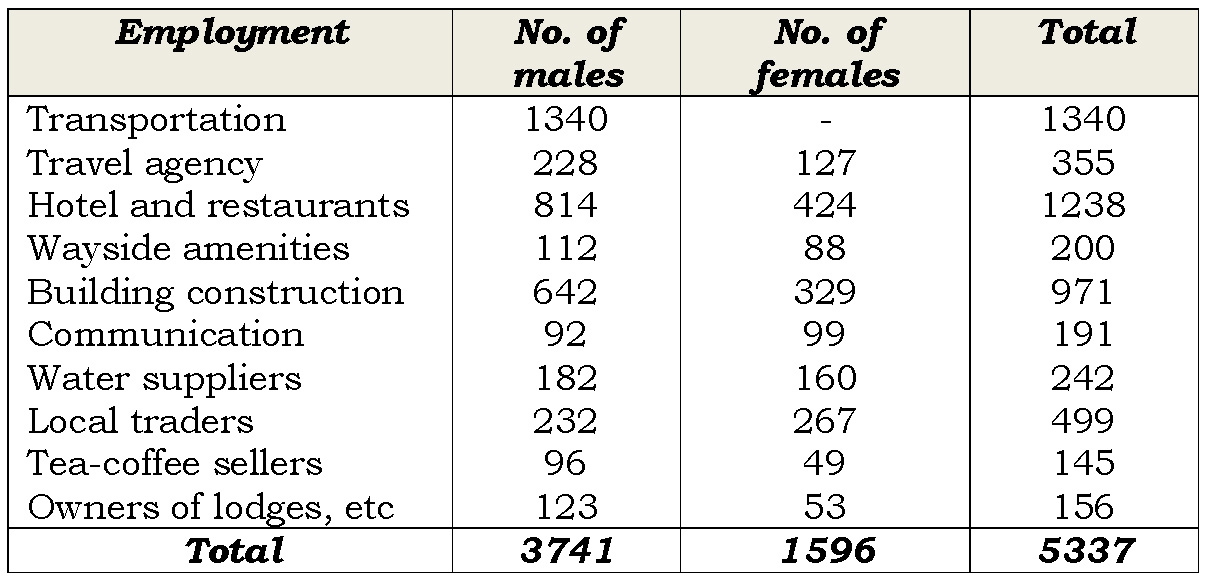
Table-4: Employment generation in Coonoor destination due to tourism industry.
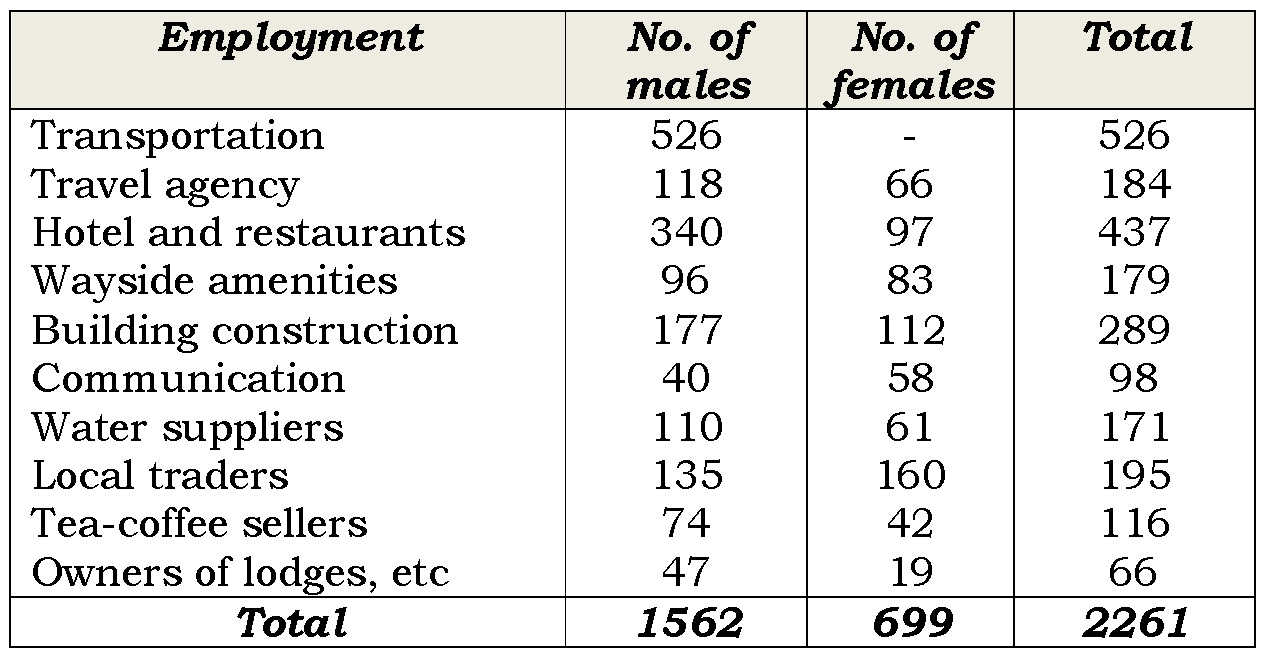
Table-5: Employment generation in Valparai destination due to tourism industry.
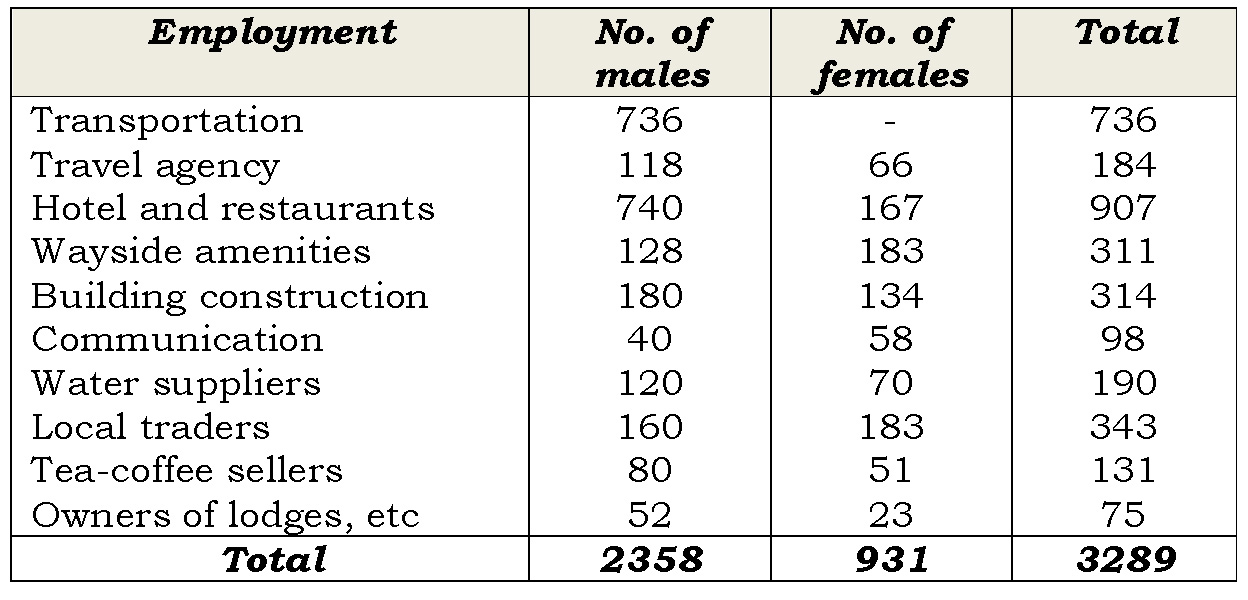
Table-6: Employment generation in Meghamalai destination due to tourism industry.
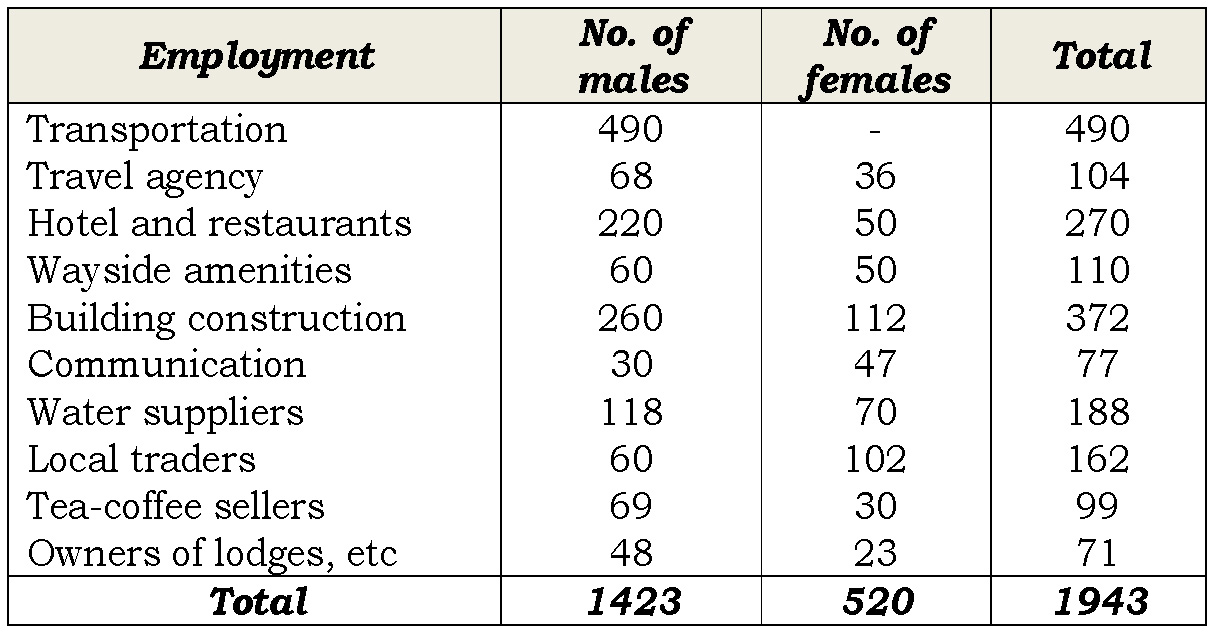
Table-7: Employment generation in Yercaud destination due to tourism industry.
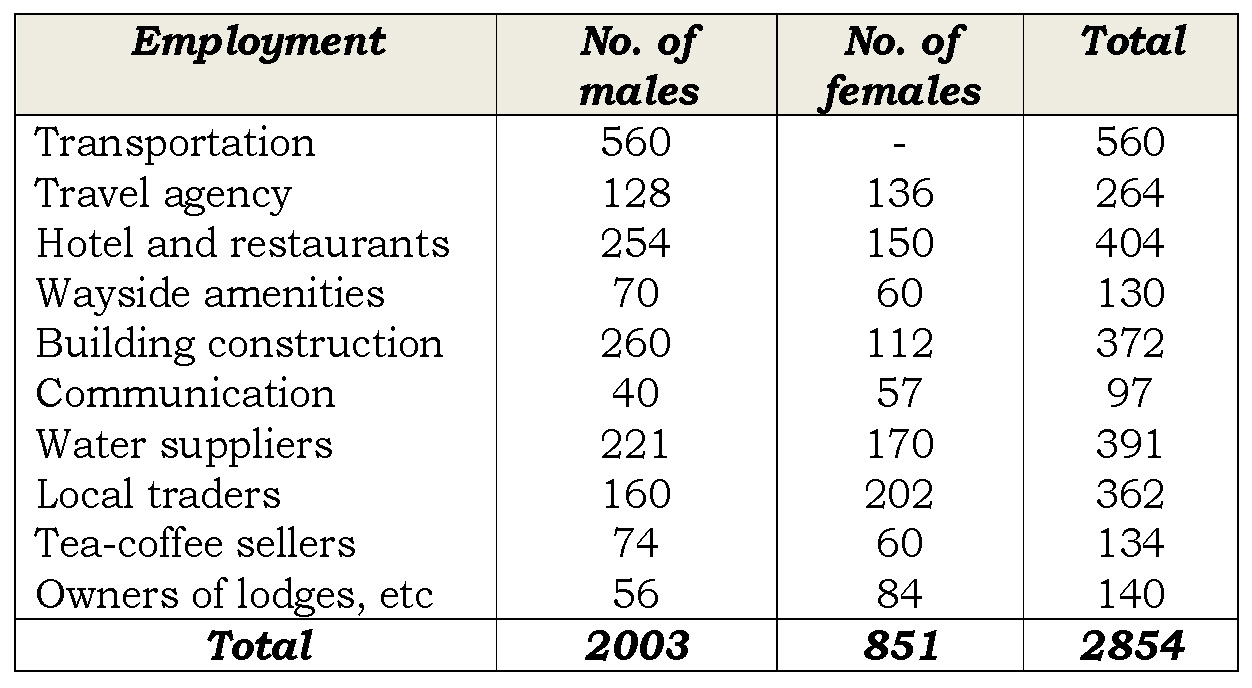
Table-8: Employment generation in Yelagiri destination due to tourism industry.
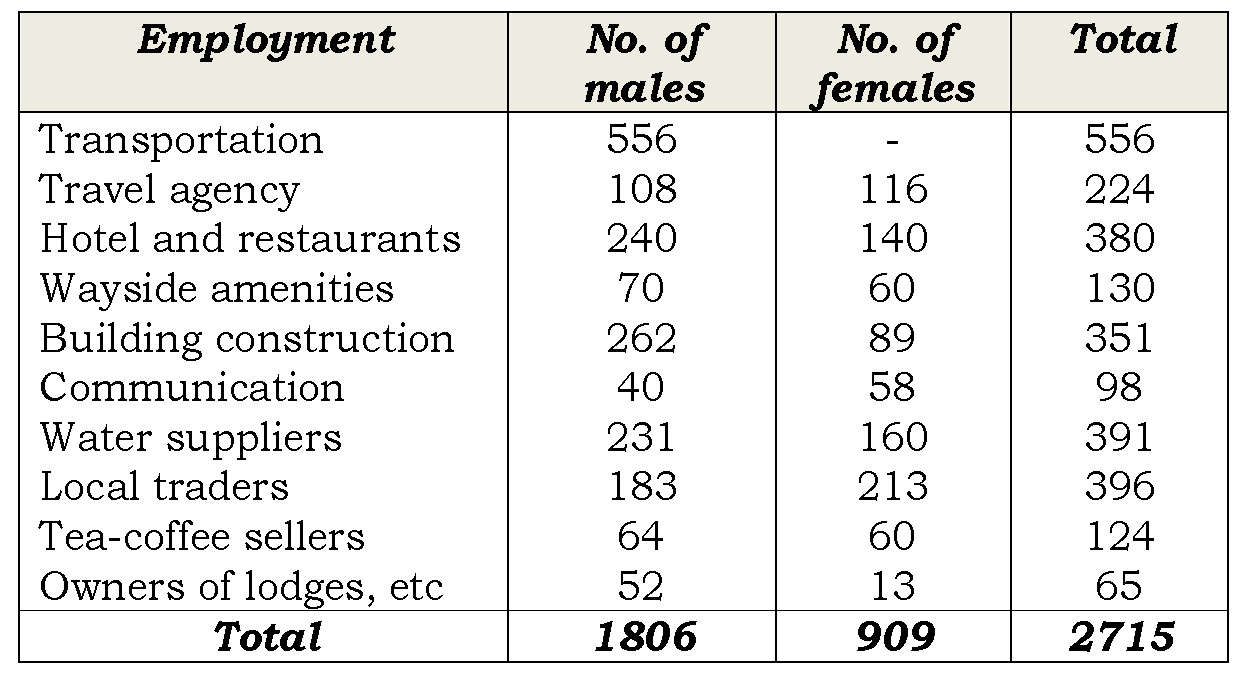
Table-9: Employment generation in Kolli hills destination due to tourism industry.
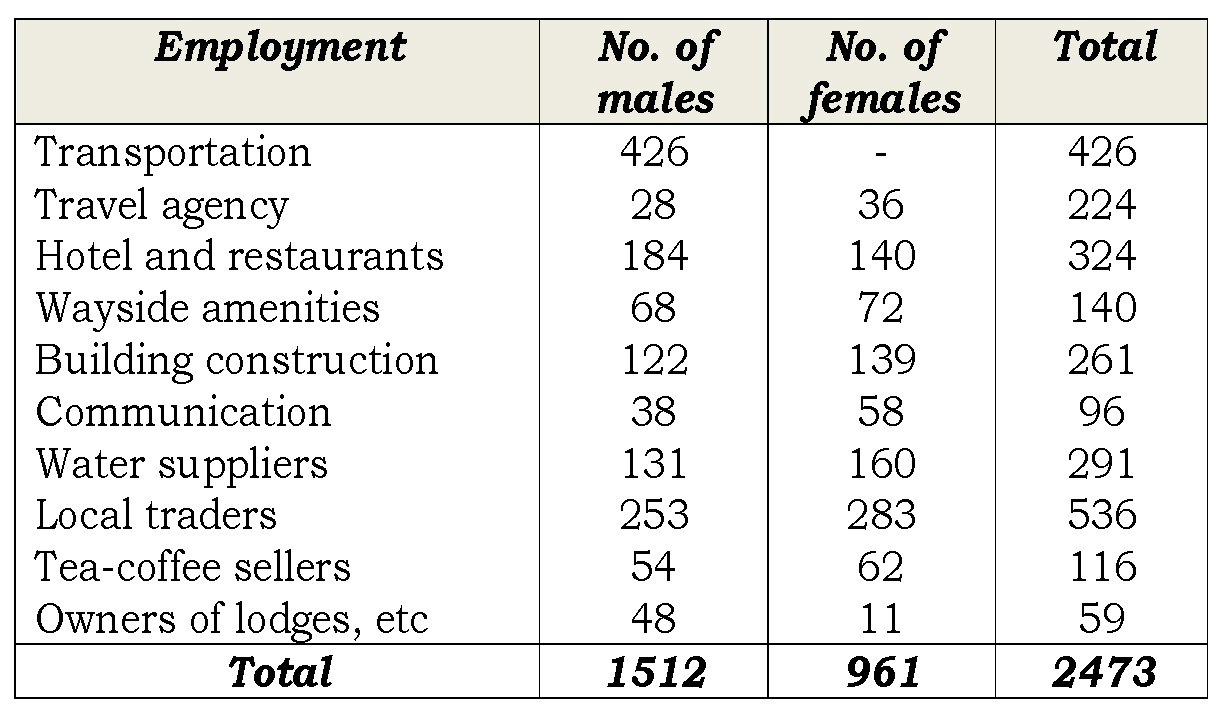
The more number of people (24.5%) are employed in the transportation sector, which does not include the usual mode of transportation through buses, railway and airways, to assist the tourists to travel from one place to other using taxies, Maxi-cabs and autos. This sector includes persons employed as drivers, cleaners, mechanics, and owners of the vehicles. The manager, travel guides, brokers and assistants helping the tour arrangement are considered as workers of travel agency, and there are about 4.4% of people working in each of these destinations. Many people are recruited as managers, room boys, cooks, service boys, room cleaners, receptionists, electricians, porter, waiter/waitress, housekeepers, executive chef and concierge in hotels and restaurants in the tourist destinations. Nearly, 19.5% of employments are generated in hotels and restaurants. Way-side amenities are important necessities that are most expected along the roadways to the tourist destinations, which include petrol pumps, repair shops, shopping area, souvenir shops, parking lots, short stays, rest rooms, tea shops, small stores, and hospitals, which recruit many people in the way along the roads to these destinations. Nearly, 5.8% of people are recruited in this sector. About 26% of people are employed in building constructions in and around the destinations, where they are recruited as masons, plumbers, welders, glazers, plasterers, assistants, contractors, engineers and so on. About 4.1% of people are working in the communication systems, especially in the internet services that are required in these destinations for communications and for recharging the mobile phones and others. Likewise, about 11.8% of people are working in the water supply to transport and distribute the purified waters in bottles or cans. Approximately, 11.6% of people got remuneration from the sale of local produces obtained from farmers and handicrafts to foreign and domestic visitors; they usually sale fruits, vegetables, coffee, tea, herbals, honey and others to tourists. About 2.4% of people do sale of coffee and tea through mobile vehicles while about 2.6% of people are owners of lodges, hotels, restaurants, guesthouses, etc., used in the stay of tourists. Employment generation increased from 10.31 per cent (in 2015) to 16.9 per cent in 2018, which is the eye-witness for the development of socio-economic conditions of the people living at the tourist destinations in due course. It should be noted that more number of people are employed in Kodaikanal and Ooty than those got job in the tourism fields of Valparai, Coonoor, Sirumalai, Yercaud, Yelagiri, and Kolli hills. In the year 2020 the employment generation is expected to be 23%.
Mrs. Amudha, Research Scholar,Department of History, DDE, Madurai Kamaraj University, Madurai – 625 021.
References:
- Executive Summary, Tourism Survey for Tamil Nadu (Jan – Dec.2014), Market Research Division, Ministry of Tourism, Government of India, Nielsen India Pvt. Ltd.
- International Passenger Survey 2003, Final Report, February, 2006, Market Research Division, Ministry of Tourism, Government of India, Horizon Industrial Consultancy Services, New Delhi.
- Final Report on 20 years Perspective Tourism Plan for the State of Tamil Nadu, Market Research Division, Department of Tourism, Ministry of Tourism & Culture, Government of India, Consulting Engineering Services (I) Pvt. Ltd, New Delhi, 2003.
- India Tourism Statistics 2014, Ministry of Tourism, Government of India.
- Policy Note 2012 – 2013, Tourism and Culture Department, Government of Tamil Nadu, 2012.
- Policy Note 2017 – 2018, Tourism and Culture Department, Government of Tamil Nadu 2017.
- Tourism Policy Note 2011-2012, Tourism and Culture Department, Government of Tamil Nadu.
- Tourism Policy Note 2016-2017, Tourism, Culture and Religious Endowments Department, Government of Tamil Nadu, 2017.
- Annual plan (Draft) Tamil Nadu 2005-2006, State Planning Commission,(2004-2005).
- Tourism Policy Note 2005-2006, Tourism Department, Government of Tamil Nadu,2005.
- Analyzing Tourism Potential of Tamil Nadu State of India: A People – Tourist’s Perception Approach, G.S. Chauhan in Journal of Environmental Research and Development, Vol. V , No.2. Oct – Dec, 2010.
- A Study of Tourist Inflow in Tamil Nadu 2001 – 2012 – A GIS Based Study, International Journal of Geomatics and Geosciences, Vol.V, No.2, 2014.
- Report of Tourism, Development of Way-side Amenities, Government of Gujarat, 2017.
- Agrawal S.P. and Gupta M., 2002, Information India: 1997-98 and 1998-99, Global View, Concept Publications, New Delhi.
- Bansal S.P., 2001., Tourism Development and Its Impact, Shri Sai Printographers,Delhi.
- Premalatha, P.N “Hop on Hop off Tour in Chennai: A New Marketing Strategy of Tamil Nadu Tourism Development Corporation” in Dileep M.R.(ed) International Marketing in Tourism, Anmol Publications, New Delhi, 2011.

